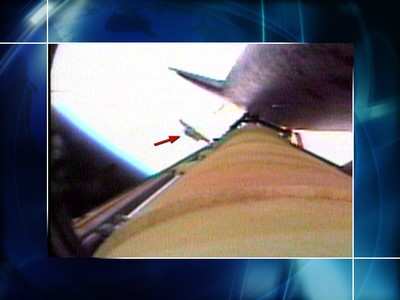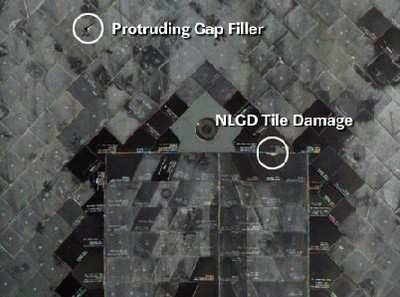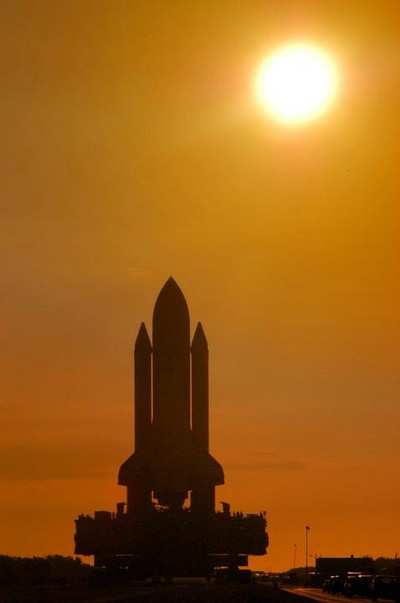No "Immediate Easy Fixes," Says NASA
By Senior Correspondent Kevin R.C. O'Brien
On Friday, the government's traditional day for slipping bad
news to the weekend-bound public, NASA pulled the plug on STS-121's
scheduled launch date of 22 September and allowed that, perhaps, a
November launch would go on as scheduled. Perhaps not.

After new, environmentally-safe CFC-free insulation caused the
loss of the orbiter Columbia and its crew of seven, NASA spent two
years and $1.4 billion analyzing the accident, making
presentations, and changing hundreds of parts and hundreds of
procedures for thousands of workers -- but stuck with the new
insulation. That decision bore consequences, when the flight of
Discovery was also threatened by chunks of loose insulation last
month.
To put it another way, fifty-six times the cost of Rutan and
Allen's SpaceShipOne program was spent -- as it turns out, not to
address the problem.
After Discovery's recent return to flight, in which the same
insulation flaked off again but fortunately caused no serious
damage, NASA is back in the PowerPoints-and-blame game with a
vengeance.

They were expecting some flaking, but no pieces big enough to
threaten the orbiter. Instead, the external tank lost hazardous
pieces in five places, mostly places where necessary attachment
points and fittings disturb the smooth regularity of the tank.
Some of these are new, never-seen-before problem areas; others,
NASA thought they fixed with redesign during the long night between
Columbia's failed reentry and Discovery's flawed launch. Both were
unanticipated and are unwelcome to NASA officials, who thought they
had beaten the insulation problem.
"We didn't find any immediate easy fixes," NASA's Bill
Gerstenmaier admitted. The most probable approach at this point, is
that NASA will redesign those five areas of the external tank, and
the way that insulation attaches to them. The detail engineering
design and substantiation of the new fittings and processes, and
the manufacture of new parts, can't possibly be done in time for a
September 22nd launch of Atlantis, hence the cancellation. Indeed,
it will be quite a feat to complete this task in time for the
November launch, which remains in pencil at this time.
Atlantis is already mated to its stack of tank and boosters in
Cape Canaveral's Vehicle Assembly Building. Workers will most
likely have to de-mate the spacecraft components in order to
install any improvements developed in response to the problems seen
in Discovery's flight.
NASA has ruled out any return to the pre-Columbian, safer, but
polluting, insulation. When the next orbiter flies, it will have
the same flaky (literally, as in "flaking off") foam insulation.
"Even the next time we fly the tank, I would expect to see a little
bit of foam loss somewhere," NASA's Bill Gerstenmaier admitted to a
media teleconference. As long as the flakes don't have enough mass
to cause serious damage to the orbiter, there's no harm in
them.
It only sounds on the surface, though, like NASA has an easy
task. One is reminded of Napoleon's saying of war: "All the
important things are simple. But all the simple things are very
hard." The practical trick is, managing foam loss so that the parts
lost do not have enough mass or motion relative to the shuttle to
damage the system. When aerodynamic forces tear a piece of
insulation off the shuttle, its large area relative to its light
weight decelerate it abruptly, creating a delta between its
velocity and that of the accelerating shuttle. That velocity delta
can lead to damaging impact forces if the foam is struck by the
lightweight structure of the orbiter.

The piece of foam that destroyed Columbia and killed seven
astronauts weighed 1.67 pounds, according to NASA calculations. The
largest piece seen on Discovery's tank cameras (one of the $1.4
billion in post-Columbia improvements) was estimated to weigh 0.9
pounds, and came from an area that was never previously thought to
be a foam-shedding problem.
Another headache for NASA is the relatively limited launch
windows available for the orbits required to reach the agency's
other struggling manned project, the International Space Station.
The Atlantis STS-121 mission is planned to bring the crew in the
ISS up to three for the first time since the grounding of the
shuttle fleet after Columbia's February, 2003 crash. Since then,
the station's been prudently limited to the two pax that a Soyuz
capsule can safely accommodate. Discovery carried some of the
supplies to support the third stationaut, and even more supplies
will come in Atlantis.

Just as much as that third man or woman, the materiel supposed
to come up in the ESA Leonardo logistics module aboard Atlantis is
critical to resumption of creative, rather than caretaker, work on
the ISS. If Atlantis makes the November flight, Space Station
construction can resume in March, 2006.
Meanwhile, the shuttle orbiter Discovery has been gone over with
minute attention to detail and is being prepared (photo) to be
mated to the specially modified Boeing 747 that brings the shuttle
back to Canaveral when it has to, like any other glider beset by
unfavorable climactic conditions, "land out."
To some extent the delays are a matter of politics with a small
"p." As a public agency, NASA is very deeply dependent on public
support, and NASA brass are keenly aware of this. The fundamental
risks of the Shuttle remain pretty much the same whether the next
launch happens in September, November, or 2007, but NASA can't
stand the political risk of not launching again, relatively soon;
it can't stand the political risk of not doing anything and then
having another mishap, either.
NASA's media strategy, as far as it went, worked. Google News
won't find you a single article on the Friday press call, although
the space specialty media, and British techie page The Register,
carried stories on it.
 ANN's Daily Aero-Linx (04.16.24)
ANN's Daily Aero-Linx (04.16.24) Aero-News: Quote of the Day (04.16.24)
Aero-News: Quote of the Day (04.16.24) Airborne 04.10.24: SnF24!, A50 Heritage Reveal, HeliCycle!, Montaer MC-01
Airborne 04.10.24: SnF24!, A50 Heritage Reveal, HeliCycle!, Montaer MC-01 Airborne 04.12.24: SnF24!, G100UL Is Here, Holy Micro, Plane Tags
Airborne 04.12.24: SnF24!, G100UL Is Here, Holy Micro, Plane Tags Airborne-Flight Training 04.17.24: Feds Need Controllers, Spirit Delay, Redbird
Airborne-Flight Training 04.17.24: Feds Need Controllers, Spirit Delay, Redbird






